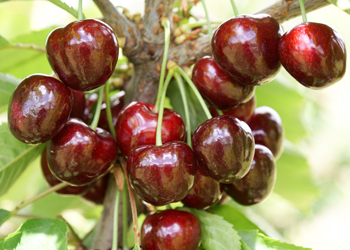
CHELAN™
PC146-23 cv.
Chelan™ PC146-23 cv. is one of the most popular early season, export quality cherry selections in the Pacific Northwest. Chelan™ is medium in size, mahogany red in color, and ripens 10-12 days before Bing. Trees must me managed properly in order to achieve optimal fruit size as the variety tends to fruit heavily. Pollen Group XVI (S3S9)
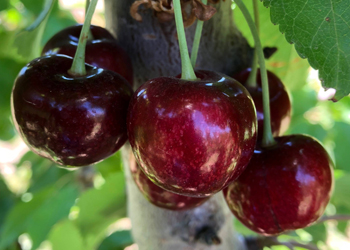
BENTON™
PC7146-8 cv. (USPP 15,847)
Benton® PC7146-8 cv. is a mid-season, high-quality cherry selection that ripens approximately 2-3 days before Bing. Benton® has excellent firmness and large fruit with superior flavor. Although self-fertile, a pollinator is recommended. Pollen Group Universal Donor (S4S9)

BING
Bing, the standard in sweet cherry selections, is medium to large in size and dark red to mahogany in color. Bing cherries are firm and crunchy with an excellent sweet / acidic flavor. Bing is highly susceptible to rain induced cracking so planting locations must be considered. Pollen Group III (S3S4).
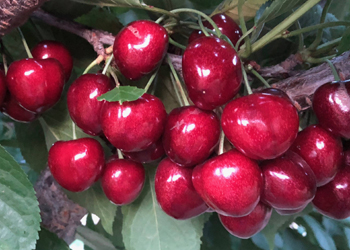
SWEETHEART
Sweetheart is a self-fertile, late cherry selection that produces large and very firm fruit. The variety is very productive producing large clusters of cherries. Harvest timing is approximately 3 weeks after Bing making it one of the latest varieties currently produced in the Pacific Northwest. Pollen Group Universal Donor (S3S4)
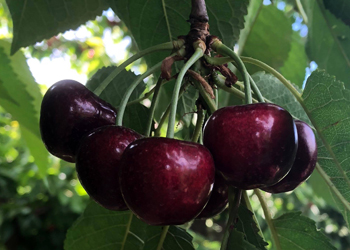
SUMMERLAND®
SKEENA cv.
Summerland® is a self-fertile, late-season selection that harvests just after Lapins within 12-15 days after Bing. The selection is large and sweet with very good firmness and crunch. Fruit is dark red to mahogany at the time of harvest. Pollen Group Universal Donor (S1S4).
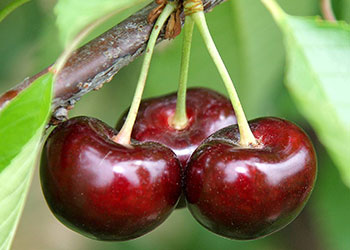
BURGUNDYPEARL®
NY 38L cv.
BurgundyPearl® NY 38L cv. produces very large, crack-resistant, dark fruit that ripen approximately 5 days before Bing. The selection is firm and crunchy and displays very good storage qualities. Pollen Group III (S3S4).
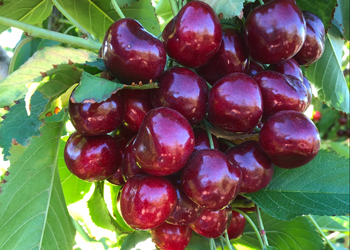
LAPINS
Lapins produces large, very firm cherries that are dark red to mahogany at maturity. The variety is self-fertile and harvests approximately 10-15 days after Bing. Lapins is very productive and flavor is rated highly. Pollen Group Universal Donor (S1S4).
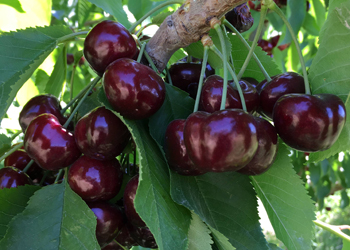
CORAL CHAMPAGNE
Coral Champagne produces export quality firm fruit that are large to very large in size. The selection ripens just after Chelan, approximately 10 days before Bing and is sweet in flavor with low acidity. Cherries are pinkish red with a glossy dark flesh at the time of harvest. Coral Champagne’s cracking sensitivity is similar to Bing. Pollen Group III (S3S4).

VAN
Van is medium in size and resembles a Bing in appearance. It is hardy and heavy bearing making it an excellent pollinizer for many other cherry selections. Van cherries are firm and sweet and ripen approximately 3 days before Bing. Pollen Group II (S1S3).
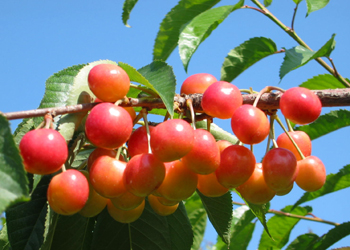
RAINIER
Rainier, the standard for blush cherries, produces large fruit with pink-red blush over a yellow background. The selection harvests approximately 5-8 days after Bing and is firm and sweet. Rainier cherries are susceptible to bruising and marking so careful handling must be practiced. Pollen Group IX (S1S4).
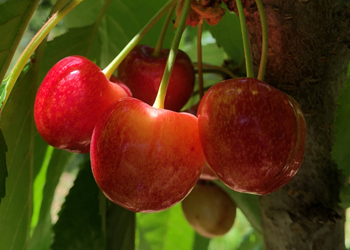
EARLY ROBIN®
Doty cv. USPP 13,951
Early Robin® Doty cv. is a medium to large blush selection that harvests 5-8 days before Bing. The fruit are firm and sweet. Early Robin® makes an excellent choice for extending the blush cherry season. Pollen Group II (S2S3).
Cultivars Resistant to Rain-induced Cracking

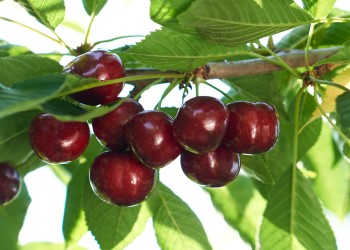
GARNET GIRL®
V84031 cv.
Garnet Girl® is a very attractive medium-large cherry, featuring a kidney shape, mahogany-black skin, and dark red flesh. These cherries are firm and sweet with excellent resistance to brown rot and moderate resistance to bacterial canker and rain-induced cracking. Harvest timing is between Chelan™ and Tieton®. V84031 cv. was bred at the University of Guelph and is offered through licensing by Vineland.
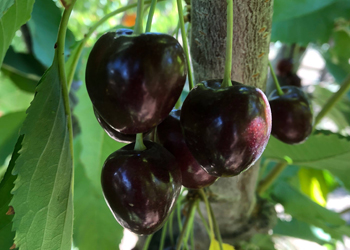
ATTIKA®
KORDIA cv.
Attika Kordia cv. is a large, long stem selection that ripens just before Lapins within 7-10 days after Bing. Attika displays very good rain crack resistance with sweet, firm and crunchy fruit. At the time of harvest, cherry appearance is very dark and has even been listed as black on some color scales. Pollen Group VI (S3S6).

REGINA™
JORK57/201 cv. (USPP 11,530)
Regina™ Jork57/201 cv. produces large to very large fruit with a good balance of acid and sugar. Regina™ ripens just after Lapins placing the harvest approximately 2 weeks after Bing. The fruit is firm and crunchy and displays very good rain crack resistance. Pollen Group II (S1S3).
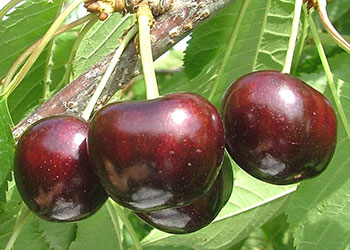
EBONYPEARL®
NY 32 cv.
EbonyPearl® NY32 cv. harvests approximately 7 days before Bing. The fruit is dark red with long, firmly attached stems. The selection is large and firm and displays very good resistance to rain induced cracking. Pollen Group IX (S1S4).
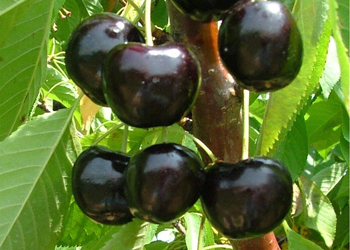
BLACKPEARL®
NY 8139 cv.
BlackPearl® NY 8139 cv. is an early season selection that ripens 10 days before Bing in the same timeframe as Chelan™. The fruit are firm and crunchy and medium in size. BlackPearl® displays very good flavor and storage qualities along with low rain induced cracking susceptibility. (S4S13)
Rootstock
MAXMA® 14
Brokforest cv. Rootstock
Trademarked as Maxma® in the USA – This hybrid rootstock is a result of a cross between Mazzard and Mahaleb. It is rated in vigor as 20-25% more dwarfing than Mahaleb. This lends itself to higher density plantings. Maxma® 14 is compatible with most cherry varieties and is quite precocious and productive. It is considered to be one of the leading rootstocks in use in Europe. Maxma® 14 rootstock is tolerant to wet soils and is resistant to iron chlorosis.
MAZZARD
Mazzard is the most common standard-size sweet cherry rootstock. It produces a vigorous tree with good anchorage. Mazzard shows some tolerance to phytophthora and will grow in a wide range of soils. This rootstock produces very few suckers.
GISELA® 6
Gisela® 6 is a semi-dwarfing stock, producing a tree that is 70-80% the size of Mazzard. The tree structure is open and round. It is early blooming and very heavy bearing. Gisela® 6 has a wide soil adaptability and does well in heavy soils. It has a good virus resistance and little to no suckering problems. Gisela® 6 needs a management system designed to maintain extensive growth to balance precocity and high bloom density. Gisela® 6 is well anchored but support is recommended.
GISELA® 12
Gisela® 12 is a precocious, semi-dwarfing rootstock that produces a tree that is approximately 60% the size of Mazzard. The tree structure is open, spreading and stocky. Gisela® 12 has a wide soil adaptability and does well in heavy soils. The rootstock is very precocious and productive. It has good virus resistance and no suckering problems. Gisela® 12 is well anchored but support is recommended.
KRYMSK® 5
Krymsk® 5 is a semi-dwarfing rootstock that produces a tree similar in size to Gisela® 6. Krymsk® 5 has proven to produce premium quality fruit, however it is not as productive or precocious as the Gisela® series in comparison. The rootstock is adapted to a wide range of soils and has good cold hardiness. Trees are well anchored and do not require support. Krymsk® 5 rootstock is sensitive to Prunus ringspot and Prunus dwarf virus so virus certified material must be selected for propagation onto this stock.
KRYMSK® 6
Krymsk® 6 rootstock produces a tree that is approximately 60% the size of Mazzard. Krymsk® 6 is adapted to cold temperatures and heavier soils. Trees are well anchored and develop wide crotch angles. Like Krymsk® 5, Krymsk® 6 is sensitive to Prunus ringspot and Prunus dwarf virus.








